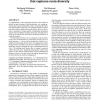Free Online Productivity Tools
i2Speak
i2Symbol
i2OCR
iTex2Img
iWeb2Print
iWeb2Shot
i2Type
iPdf2Split
iPdf2Merge
i2Bopomofo
i2Arabic
i2Style
i2Image
i2PDF
iLatex2Rtf
Sci2ools
SIGCOMM
2006
ACM
2006
ACM
Building an AS-topology model that captures route diversity
An understanding of the topological structure of the Internet is needed for quite a number of networking tasks, e.g., making decisions about peering relationships, choice of upstream providers, inter-domain traffic engineering. One essential component of these tasks is the ability to predict routes in the Internet. However, the Internet is composed of a large number of independent autonomous systems (ASes) resulting in complex interactions, and until now no model of the Internet has succeeded in producing predictions of acceptible accuracy. We demonstrate that there are two limitations of prior models: (i) they have all assumed that an Autonomous System (AS) is an atomic structure — it is not, and (ii) models have tended to oversimplify the relationships between ASes. Our approach uses multiple quasi-routers to capture route diversity within the ASes, and is deliberately agnostic regarding the types of relationships between ASes. The resulting model ensures that its routing is cons...
| Added | 14 Jun 2010 |
| Updated | 14 Jun 2010 |
| Type | Conference |
| Year | 2006 |
| Where | SIGCOMM |
| Authors | Wolfgang Mühlbauer, Anja Feldmann, Olaf Maennel, Matthew Roughan, Steve Uhlig |
Comments (0)

